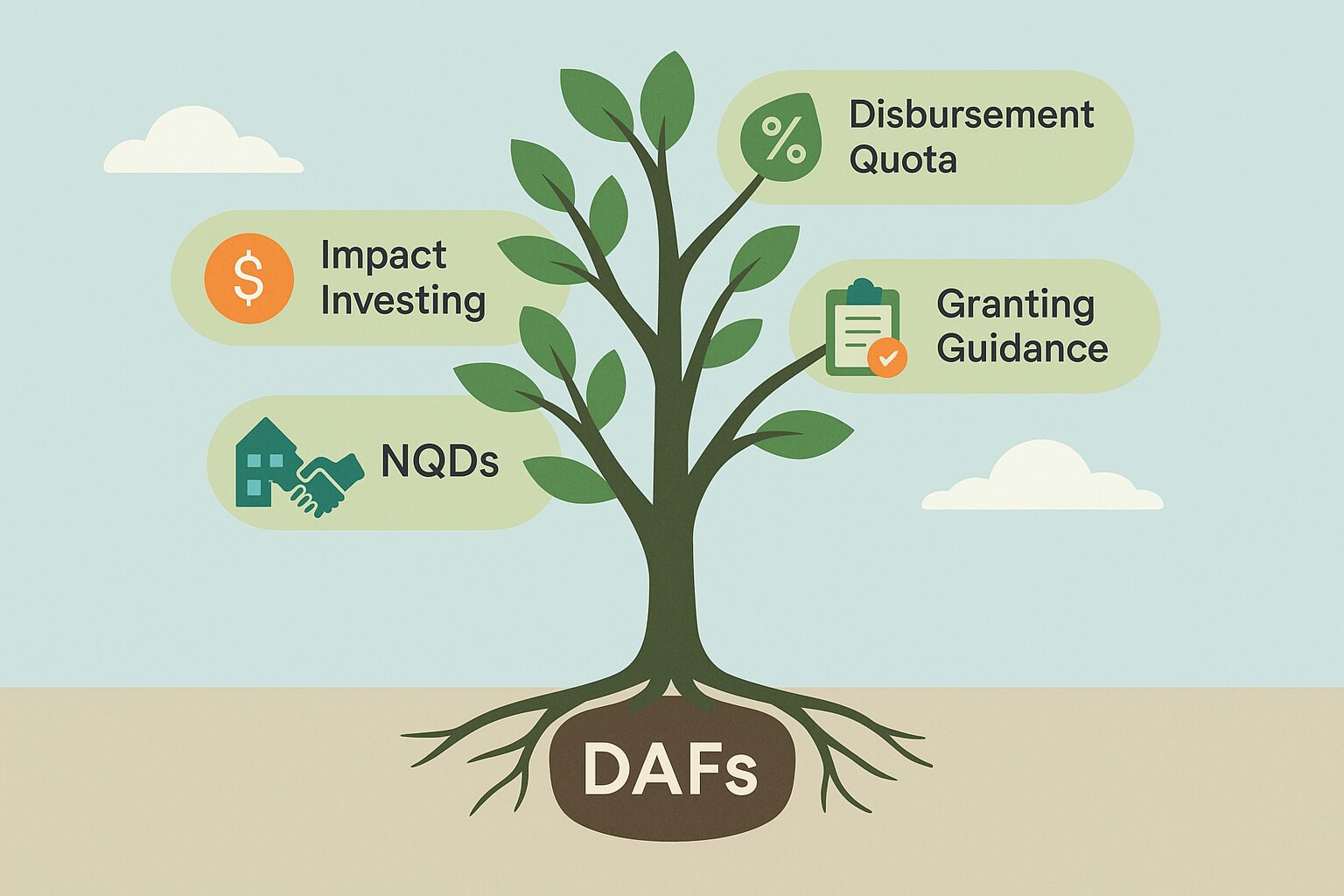Donor advised funds (DAFs) have emerged as one of the most popular vehicles for charitable giving in Canada, offering flexibility, administrative simplicity, and increasingly, a broader suite of services. As the DAF landscape evolves, new trends and conversations are shaping how DAFs operate — and what donors expect from them. In this post, we highlight four hot topics for DAFs that every donor, advisor, and foundation board member should understand.
5% for All? Rethinking Disbursement Expectations
One of the ongoing debates in the DAF world centers around disbursement expectations. While private foundations are required to grant a minimum of 5% of assets annually (known as the “disbursement quota”), DAFs are not held to the same account-level requirement.
Some DAF sponsors choose to apply their own internal standards, such as Benefaction Foundation, who requires fundholders to grant a minimum amount each year. Others have no formal requirement, relying instead on donor initiative such as the Charitable Impact Foundation.
It’s important to recognize that, on a foundation-wide basis, most DAFs grant well above the minimum disbursement quota. This is because many accounts function as “flow-through” vehicles, with donors contributing and granting within the same year. However, for endowed accounts, the question becomes philosophical: Is capital accumulation an acceptable strategy for maximizing future giving? Or should charitable dollars be moved quickly into the community, especially since these funds are no longer legally donor-owned?
Donors and advisors alike are beginning to re-express their values through how they approach investing and granting. Whether a donor sees their DAF as a long-term philanthropic endowment or a near-term giving vehicle, aligning intent with action — and policy — is a hot topic.
Expanding Horizons: Impact Investments in DAFs
As donor interest in aligning investments with values grows, impact investing has become another hot topic for DAFs. Some organizations, like the Toronto Foundation, offer donor pools with impact-focused investing mandates — allowing capital to generate both financial and social returns. Others are going further by using discretionary (non-donor-directed) capital to fund mission-aligned projects such as affordable housing initiatives or local community loans as some community foundations do.
The evolution towards impact investment is significant. It signals a shift from DAFs functioning solely as passive conduits for donations to becoming active stewards of capital with total mission alignment. For donors seeking to integrate investment and philanthropic goals, these offerings expand what’s possible.
In Canada, the impact investing sector of DAFs has room to mature. While in the US, there are lots of DAFs that specialize in impact investing specifically.
Working with Non-Qualified Donees: Risk and Reward
Another emerging area of interest involves grants to non-qualified donees (NQDs) — organizations that do not hold registered charity status but are doing valuable work in their communities. With recent regulatory changes and growing donor interest in equity and innovation, more DAFs, especially community foundations, are stepping into this space.
But this opportunity brings with it compliance complexity. Grants to NQDs must be structured in accordance with CRA guidance, ensuring that funds are used exclusively for charitable purposes. DAFs must establish clear procedures to avoid risks such as directed gifts, private benefit, or conflicts of interest.
Some foundations are taking a leadership role, such as Myriad Canada, by educating donors and sector peers. Done thoughtfully, a compliant approach to NQDs allows donors to fund projects and organizations that are meaningful and impactful, even if they fall outside traditional definitions — but they must be done with compliance and governance leading the way.
From Passive to Active: DAFs Offer More Granting Guidance
As the line between private foundations and donor advised funds continues to blur, many DAF sponsors are expanding their services to include granting guidance and impact measurement. This marks a shift from a historically “hands-off” model to one that’s closer to how family foundations traditionally operated.
Donors who might once have operated a private foundation are now choosing DAFs for their ease of administration — and they’re looking for a comparable level of support in shaping their giving strategies. In response, more DAFs are offering research, due diligence, site visit coordination, and post-grant impact reporting to help donors engage more deeply with their giving. Recently, I visited Canada Gives Foundation to learn about the enhanced granting guidance and reporting services they are providing their donors.
It’s not just about donor satisfaction — it’s about increasing the effectiveness of philanthropy. As more foundations consider “rolling into” a DAF structure, the demand for thoughtful, tailored granting support will only grow.
The Future of DAFs Is Active, Aligned, and Accountable
Donor advised funds are no longer just administrative tools for giving — they’re becoming platforms for values-based strategic philanthropy, impact investment, and enhanced reporting. Whether the issue is disbursement practices, new investment opportunities, compliance with CRA rules around NQDs, or enhancing donor services, these hot topics for DAFs point to a sector in transformation.
If you’re a next-gen philanthropist or budding impact investor, our family office would love to help you achieve your financial goals. Get in contact with us here!




